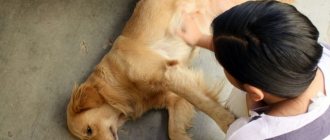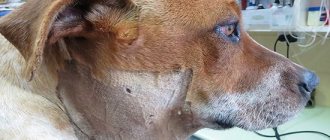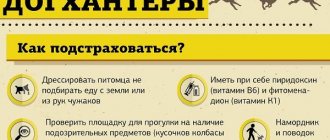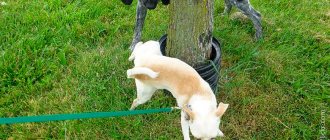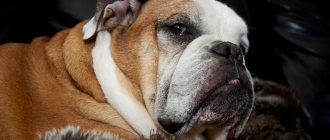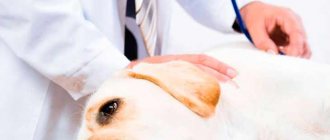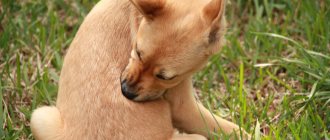What is tartar
Tartar is a hard mixture of food particles and microorganisms impregnated with minerals. The formation process takes place over 4-6 months. Initially, a thin biofilm becomes visible, which consists of microbes and waste products that appear during their functioning. In the absence of oral care, food debris accumulates, plaque thickens and a plaque appears. If such formations are not removed from the enamel of the teeth, the accumulations of mucus will harden. This is how tartar is formed.
The main signs of the presence of tartar in a pet:
- Nauseating odor from the mouth;
- Plaque – yellowish in the initial stages of stone formation; dark in later stages; localization – often at the base of the tooth;
- In advanced cases, loose gums and bleeding are observed; The dog constantly scratches the inflamed areas and may refuse to eat.
Why do dog gums bleed?
Overgrown tartar always causes the gums to swell and bleed. This is the beginning of a disease called gingivitis.
In addition to swelling, bleeding, and obvious signs of gum inflammation, the dog’s breath begins to stink, smelling like rot.
How to treat bleeding gums in a dog.
Treatment of bleeding gums caused by enlarged tartar should be discussed with your veterinarian. Because the specialist knows how to treat the dog. Basically, the animal is prescribed a comprehensive treatment, consisting of removing deposits on the teeth, introducing dry food or raw vegetables (carrots, apples) into the diet that need to be chewed, and using special means to care for the oral cavity. In case of severe inflammatory processes, you will have to give the dog antibiotics.
Gums bleed when brushing your dog's teeth.
If a dog’s gums bleed when brushing their teeth, the reason may be the hard bristles of the brush, which damage the skin of the gums, or damage caused by the movement of the stone towards the gums. But, whatever the reason, bleeding is not a good sign.
What should you do if every brushing of your teeth is accompanied by bleeding?
- replace the brush.
- After cleansing, wipe the dog’s fangs and incisors with hydrogen peroxide (3% solution).
And if such simple methods do not help stop the bleeding, then contact your veterinarian.
Possible reasons for the appearance
The reasons why dogs develop tartar are varied. Some factors are of external origin and can be successfully controlled by the owner:
- Lack of regular care for the pet’s oral cavity, mucous membranes and teeth;
- Mistakes in organizing the dog's diet.
Other circumstances of the occurrence of tartar are of an endogenous (internal) nature:
- Metabolic disease;
- Irregular structure of teeth;
- Natural hyperacidity in dogs.
Dental care
The intensity of brushing the teeth and oral cavity depends on the size of the dog. Representatives of large and medium-sized breeds need to undergo a preventive dental examination 1-2 times a month. Considering that these dogs are usually fed a natural diet (including bones), plaque removal is often done naturally. The use of special powders and toothpastes is not necessary in most cases. Small breed pets should brush their teeth once a week. It is necessary to use toothpastes enriched with vitamins.
Treatment of inflammatory processes is carried out in a veterinary clinic, regardless of the size of the dog.
Nutrition
Feeding mistakes made by owners can lead to the formation of tartar.
In order to keep your pet’s teeth in good condition for a long time, sweets, sausages, and most fruits are excluded from the diet.
Metabolism
Among various malfunctions in the functioning of a dog’s body, the main reason for the appearance of tartar is a violation of the water-salt balance. Deviations are usually associated with insufficient activity of the pet.
But in some cases, fluid retention and high concentrations of chloride and sodium ions appear due to internal kidney disease or heart failure. Diagnosis is carried out by a veterinarian.
Structure of teeth
In the absence of proper attention to the replacement of baby teeth in a puppy, a malocclusion may develop in a growing dog. This often serves as an additional factor that increases the chance of developing tartar.
Increased acidity
Another factor in the occurrence of tartar is the increased acidity of the alkaline environment of saliva in dogs. This is a natural characteristic of the species and cannot be adjusted.
Why do stones form on dogs' teeth?
Brushing your pet's teeth is not a whim, but a necessary reality. The fact is that if the condition of a dog’s fangs and incisors is neglected, then a hard plaque will form on them and adhere to the teeth.
We will not dwell on explaining what tartar looks like, since it is not particularly different from tartar in humans.
There are several reasons why stones appear in teeth, but they are all related to the processes of the digestive system:
- wrong dog diet. Keeping dogs at home contributed to a gradual shift away from natural teeth cleaning. Wild predatory animals, which include dogs, do not need to brush their teeth, since tearing and chewing prey, the process of cleaning the fangs and incisors occurs on its own.
Dog owners include soft food and canned food in their four-legged friend’s diet that does not require prolonged chewing.
Thus, the natural friction of solid food against the fangs and incisors does not occur and, accordingly, tartar begins to form.
- an impaired water-salt balance in the body with increased acidity of saliva also provokes the appearance of stone on the teeth. Here, too, there is a clear connection with poor nutrition, which, together with the animal’s sedentary lifestyle, leads to such problems.
- Excess sugar in your dog's food.
Is it necessary to remove tartar in dogs?
Tartar itself, as a rule, does not pose a direct threat to the life of a dog. However, a secondary factor, which manifests itself as a complication in the form of chronic gum inflammation and tooth loss, significantly undermines the animal’s health.
An unpleasant odor from the mouth is not the worst thing that can cause stones on the fangs and incisors. The stone is literally teeming with bacteria that multiply at an amazing rate, which can cause caries, gingivitis, bleeding gums, loosening and loss of teeth. Subsequently, the dog’s body becomes intoxicated, gastrointestinal problems begin, and sepsis develops. We won't continue further.
We think that this information is enough to confirm not only the advisability, but also the necessity of monitoring the dog’s teeth, cleaning them and removing tartar.
Is tartar dangerous?
Tartar does not pose an immediate threat to the life of a pet. However, against the background of enamel damage, various diseases can develop. These include periodontal disease, which leads to tooth loss and general intoxication of the body. In addition to severe suffering, this can lead to diseases of the gastrointestinal tract, respiratory system and, ultimately, to the death of the pet.
The condition of the teeth is the main indicator of the dog’s overall health. Therefore, you should not ignore the appearance of plaque. If you cannot clean your teeth yourself, you should contact a veterinary clinic.
What is the danger?
Tartar does not disappear on its own; it must be removed at home or by a veterinarian. Otherwise, the growths lead to a wide variety of diseases, and they, in turn, threaten the health and life of the pet. What to watch out for:
- tooth decay and subsequent abscesses (suppuration);
- digestive problems;
- exhaustion of the dog - due to unpleasant sensations while eating, it stops eating properly;
- respiratory tract diseases.
Sometimes the rapid formation of plaque and stone may indicate that the dog is experiencing negative changes in its body. In this case, urgent diagnosis and timely treatment are required.
Methods for removing tartar
The procedure for removing the stone is extremely unpleasant for the pet and can be done in two ways:
- without the use of anesthesia;
- using anesthesia.
The first option is certainly the safest for the dog. In order for an adult animal not to resist manipulation, it must be accustomed to the procedure from puppyhood.
If the pet generally does not resist, stone removal is carried out without the use of anesthesia or using local anesthesia. The veterinarian fixes the dog's mouth with a special device. The animal itself is also immobilized, which allows the procedure to be carried out.
When choosing a method of removal, the type of nervous system and level of training are of no small importance. In the following cases, stone removal without anesthesia is not recommended:
- dogs with increased excitability;
- pets who have not taken obedience courses (minimum OKD);
- representatives of security and guard breeds with a high level of aggression.
For the listed groups, teeth cleaning is carried out under general anesthesia. This method involves preliminary additional research - a blood test, ECG, and in some cases x-rays. Other recommendations concern the pet’s behavior on the eve of the “surgery” - lack of food and active exercise for at least 12 hours.
Cleaning Methods
All methods of removing tartar can be divided based on their effect on plaque. There are currently three main options:
- Using ultrasound;
- Mechanical cleaning;
- Dry cleaning.
Ultrasonic cleaning
Is the most effective way. As a result of exposure, the stone is completely removed, tooth enamel is slightly damaged. The procedure is performed in a hospital setting using a specialized apparatus. The impact on dental plaque is carried out by ultrasonic waves. The destruction of the stone and its detachment from the tooth occurs. At the end of the procedure, disinfection is carried out. In some cases, depending on the general condition of the oral cavity (presence of infections), a course of antibiotics may be prescribed.
Ultrasonic cleaning is the least traumatic. It is recommended to carry out once a year.
Mechanical cleaning
Mechanical cleaning is considered a cheaper way to remove stone. It is the physical scraping of plaque using dental instruments (curettes, scalers). It can be recommended at the initial stage of tartar formation for quiet, non-conflict dogs.
Mechanical cleaning is indicated for focal localization of stones on individual teeth.
When is the best time to contact a veterinarian?
Although there are enough products on sale to rid your dog of tartar, in case of large deposits, and also for the first time, it is better to consult a veterinarian. Removing stones on your own risks infection entering the tooth cavity (especially in the presence of a carious process), damage to the gums, and inflammation of the soft tissues and oral cavity. In addition, the animal may suddenly jerk and get injured. And finally, the specialist will not only properly clean your pet’s teeth, but will also carry out sanitation, ensure that the results are consolidated, and give recommendations for further care.
Where to carry out the cleaning procedure
Tartar removal can be done in a veterinary clinic or at home.
It is recommended to contact the clinic:
- inexperienced owners;
- with large dogs;
- in advanced cases (spread of stone over the entire surface of the tooth, plaque is usually dark in color).
In veterinary clinics
Tartar removal at a veterinary clinic can be carried out either mechanically or using an ultrasound machine. Currently, cleaning is most often carried out using ultrasound. In this case, the issue of using anesthesia is decided in each individual case individually.
Cost of the procedure
The cost of the procedure depends on the method of implementation. Mechanical cleaning is carried out if tartar is detected on individual teeth. The price for the Moscow region ranges from 100 rubles. for 1 tooth. The duration of the procedure depends on the number of teeth undergoing the procedure (on average 1-2 minutes for one tooth).
The ultrasound procedure is carried out comprehensively - the entire dentition is processed. In the capital's veterinary clinics the cost is 1,500 rubles. The duration is from 20 to 40 minutes.
The service of accompanying an anesthesiologist is paid separately and costs from 800 rubles.
At home
In most cases, it is impossible to remove formed tartar at home. The exception is single stones, which can be cleaned mechanically.
When it comes to teeth cleaning outside the clinic, it usually means removing soft plaque. This method can conditionally be called chemical, since in these cases special substances are used (separately or as part of objects):
- Sprays with a cleansing effect. They do not affect the dog’s sense of smell and are easy to use. The spray is applied to the tooth, and water and food are removed from the dog’s access. After a specified time, the residues are removed with a sterile bandage. Cost – from 600 rubles.
- Pastes and powders for removing plaque. They differ from pastes that are used for prevention by a higher abrasive index. It is not recommended to use specialized pastes more than once a week.
- Chewy treats. In addition to the joy your pet will experience when receiving such a bone, regular use will help remove plaque.
Video: how to remove tartar and brush your dog’s teeth
How to brush your dog's teeth.
We all know that any disease is easier to prevent than to treat later. This also applies to tartar. In order not to worry in the future about how to remove/remove plaque on your teeth, you need to take preventative measures, which include basic brushing of your teeth at home.
What is the best way to brush your dog's teeth?
Cleaning the fangs and incisors from plaque is carried out with a regular toothbrush, but with a special dog paste.
Pastes that are produced for use by people are absolutely not suitable for dogs. They contain sodium sulfate, which when applied begins to turn into foam, which causes dissatisfaction in animals.
Therefore, special non-foaming pastes have been developed for dogs that the animal can swallow. And nothing will happen to the pet.
White plaque on a dog's teeth cannot be cleaned off.
When dog paste fails to remove white plaque, you can use a homemade mixture of regular tooth powder and a 3% hydrogen peroxide solution.
Apply the mixture to whatever you are going to use to clean plaque on your teeth (brush, gauze, cotton pad) and go over the fangs and incisors of your four-legged friend.
How can you brush your dog's teeth if there is no toothpaste?
If there is no paste, then plaque can be removed from fangs and incisors using products that cleanse the animal’s oral cavity and freshen breath. For example,
- chewable bars/tablets for cleaning teeth;
- a treat that supports oral health;
- menthol tablets;
- spray for cleaning fangs and incisors.
All these special products are sold in veterinary pharmacies.
In addition, pet stores offer a wide range of rubber toys, which, in addition to pleasing the dog, also clean the teeth and massage the gums.
Externally, such toys are distinguished by the fact that they are covered with small teeth.
Prevention of occurrence
Preventive measures are aimed at preventing the formation of tartar. The main measures in the fight against plaque are:
- Examination of the pet's oral cavity 1 to 4 times a month, depending on the size and age of the dog (in general, increased attention should be paid to the health of dogs over 5 years old).
- Timely cleansing of the tooth surface from soft deposits (at the stage of dental plaque).
- Use of bones in food (in pure form or as a treat).
The formation of dental plaque is a natural physiological process. During this time, cleaning procedures can significantly slow down the formation of tartar in dogs.
5 / 5 ( 1 voice )
Home Removal Products
You can get rid of minor lime deposits on enamel at home using special products and preparations:
- paste or gel;
- spray;
- drops;
- dental fluids;
- chewable treats and toys.
Beaphar dog-a-dent gel ─ toothpaste for dogs, produced in gel form. Fights soft deposits on teeth. Prevents the formation of tartar with regular use.
Cliny gel with silver ions cleanses teeth of mineralized deposits and prevents their reappearance. Fights inflammation and bleeding gums. Contains propylene glycol, which softens tooth stones. To prevent deposits, use Cliny oral fluid.
The Oral Clean & Care line produces gels and sprays designed to combat fermented deposits on dog teeth.
Tropiclean drops are intended to be added to a bowl of drinking water. Suitable for use with small dog breeds (Maltese, Spitz, Yorkies, Pekingese, etc.). The composition contains green tea extract, citrus acid, potassium sorbate, chlorophylline, cetylpyridinium chloride and glycerin. Drops are used in the presence of small deposits and for preventive purposes. Tooth gel is also produced under the same name.
The Gosbits Dental line of dog treats to prevent plaque is produced by Gosbi Petfood.


